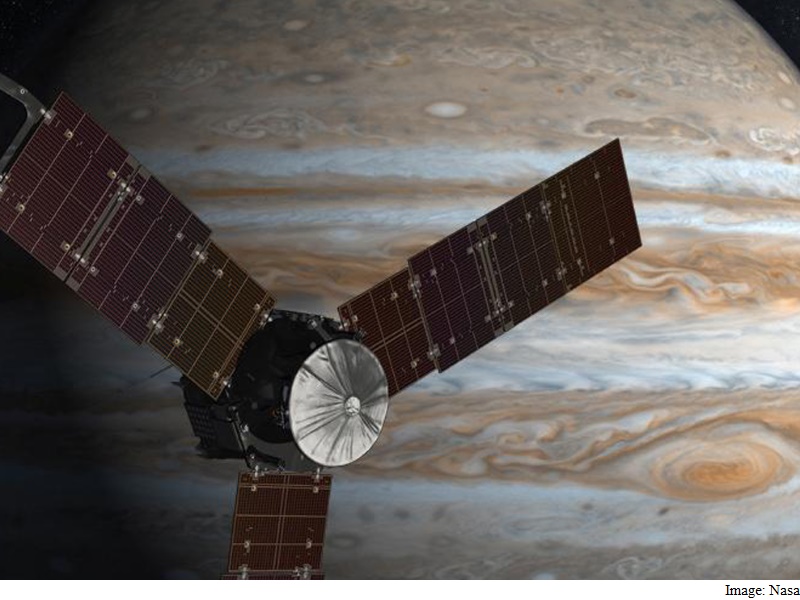- Home
- Science
- Science Features
- What Is the Goal of Juno's Mission to Jupiter?
What Is the Goal of Juno's Mission to Jupiter?

The arrival was a triumph for the $1.1 billion project to get closer to Jupiter, a mysterious "planet on steroids" where everything is extreme, the atmosphere is poisonous and the radiation is 1,000 times the lethal limit for a human, according to principal investigator Scott Bolton.
What are the great mysteries about Jupiter?
Jupiter, the largest planet in our cosmic neighborhood, is believed to be among the first to have formed in the solar system. But how did it form? Scientists still don't know.
Like the sun, it is made up of mostly hydrogen and helium, so it may have captured most of the material left after the sun came to be.
"Did a massive planetary core form first and gravitationally capture all that gas, or did an unstable region collapse inside the nebula, triggering the planet's formation?" Nasa asked.
What does the mission hope to learn?
The Juno mission aims to peer beneath the clouds around Jupiter for the first time to learn more about the planet's atmosphere.
How much water the planet contains is also a key figure, because it will tell scientists a lot about when and how the planet formed.
Bolton also said Juno is likely to discover more moons around Jupiter, which is already known to have 67.
It also aims to probe how the planet's intense magnetic field is generated, and study the formation of auroras - streamers of light in the sky caused by energy from the sun and electrically charged particles trapped in the magnetic field.
How will it find out?
By measuring the amount of water and ammonia in Jupiter's atmosphere, the spacecraft can determine if the planet has a solid core, "directly resolving the origin of this giant planet and thereby the solar system," said Nasa.
Juno will also map Jupiter's gravitational and magnetic fields.
Juno is carrying nine science instruments and also has a camera that can capture still images and video of Jupiter and its moons.
What are the risks of getting so close to Jupiter?
Jupiter's magnetic field is nearly 20,000 times as powerful as Earth's, and the planet is surrounded by an intense radiation belt.
This radiation amounts to 100 million X-rays in the course of a year, according to Heidi Becker, senior engineer on radiation effects at Nasa's Jet Propulsion Laboratory.
The electronics inside Juno were shielded inside a titanium vault to protect them against this onslaught of radiation.
For the latest tech news and reviews, follow Gadgets 360 on X, Facebook, WhatsApp, Threads and Google News. For the latest videos on gadgets and tech, subscribe to our YouTube channel. If you want to know everything about top influencers, follow our in-house Who'sThat360 on Instagram and YouTube.
Related Stories
- Galaxy S24 Series
- MWC 2024
- Apple Vision Pro
- Oneplus 12
- iPhone 14
- Apple iPhone 15
- OnePlus Nord CE 3 Lite 5G
- iPhone 13
- Xiaomi 14 Pro
- Oppo Find N3
- Tecno Spark Go (2023)
- Realme V30
- Best Phones Under 25000
- Samsung Galaxy S24 Series
- Cryptocurrency
- iQoo 12
- Samsung Galaxy S24 Ultra
- Giottus
- Samsung Galaxy Z Flip 5
- Apple 'Scary Fast'
- Housefull 5
- GoPro Hero 12 Black Review
- Invincible Season 2
- JioGlass
- HD Ready TV
- Laptop Under 50000
- Smartwatch Under 10000
- Latest Mobile Phones
- Compare Phones
- Samsung Galaxy C55
- Blackview Hero 10
- Oppo K12
- Vivo Y200i
- Huawei Pura 70 Pro
- Huawei Pura 70
- Vivo V30e
- Itel Super Guru 4G
- Asus ZenBook Duo 2024 (UX8406)
- Dell Inspiron 14 Plus
- Realme Pad 2 Wi-Fi
- Redmi Pad Pro
- boAt Storm Call 3
- Lava ProWatch Zn
- Samsung Samsung Neo QLED 8K Smart TV QN800D
- Samsung Neo QLED 4K Smart TV (QN90D)
- Sony PlayStation 5 Slim Digital Edition
- Sony PlayStation 5 Slim
- Voltas 1.5 Ton 3 Star Split AC (183 Vectra Elegant 4503545)
- Hitachi 1.5 Ton 5 Star Inverter Split AC (RAS.G518PCBISF)

















